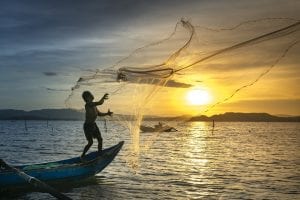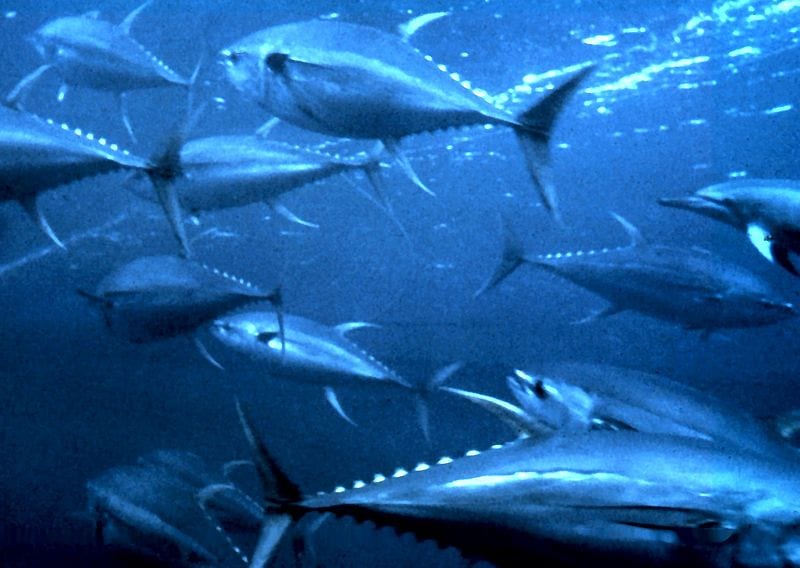The smart nets, catch sensors, live video, and reporting software are nice, but it all starts with the individuals in the trenches.
Depending on who you ask, you’ll get a completely different perspective of what people think the future of fishing looks like. Old school recreational anglers will tell you that sustainability initiatives are all smoke and mirrors and that the water is as healthy as it ever was. Scientists and environmental advocates will tell you that we have as little as 27 years until the ocean is completely depleted of fish stock.
BACKGROUND: HUMBLE BEGINNINGS LEAD TO AN UNCERTAIN FUTURE OF FISHING
How did we get to this point? How did fishing become such a taboo topic when it’s such a necessary piece of our existence?
Many believe it’s because the industry has remained “behind the times” in its implementation of technology. The future of fishing demands the industry catch up with the rest of the world. Almost all economic sectors have begun equipping themselves for the future, and the fishing industry continues to fall behind. All the while, waste, bycatch, and poor practices kill our fish, harm our oceans, and hurt coastal communities.
A tiny percentage of fisheries worldwide actually use data and computer science to manage and optimize their fishing. Most don’t even keep track of what they catch other than on paper. This is so easily manipulated and is part of the reason why overfishing is such a problem. There’s no trail, there’s no way to track anything, and as a result, there’s no way to enforce laws and regulations that prevent fisheries from taking more than their fair share.
Creating “smart boats” using satellites and cellular networks is the plan for the future. This will make the business of fishing more efficient and sustainable, and it will create jobs and boost profits. While we’re at it, we need to address the mismanagement of fisheries that have been going on for decades. Lack of regulation, rules, and tons of government money leads to corruption.
It wasn’t always this way. Coastal communities used to rely on small boats sending out “mom-and-pop” style fishermen to catch whatever they could at night so they could sell it at the fish market in the morning. Rinse and repeat. What happened?
Subsidies are believed to be the culprit. The governments of the world pump 35 billion dollars into the commercial fishing industry each year. This money doesn’t go to the small “mom-and-pop” shop, though. It goes to the largest commercial fishing operations to reduce their costs and make it easier for them to operate even with the dropping fish stocks.
ANALYSIS: WILL TECHNOLOGY SAVE FISHING?
The sad reality is that fishing could go in one of two directions. We could continue as we are, and we’ll be lucky if we don’t deplete most fish stock by 2050. Now is the time to make a change and start implementing new technology. Thankfully, there are plenty of great companies out there making a difference.
The cost and inefficiency of commercial fishing monitoring is a good start. Right now, fisheries have no way of tracking how many fish their ships are catching unless they come into the marina and get caught by the authorities. The strategy that many fisheries deploy is having an onboard “monitor” who will take note of the catch, keep track of everything, and act as the checks and balances for the fishermen.
A significant problem with this is that the data is usually inaccurate, and it’s such a slow process that it can take months for the data to even make it back to the agencies in charge of sustainability.
The future of monitoring is in sensors similar to a queue in an amusement park. Amusement parks can track how many guests move through certain areas using those rotating bars you push down when you walk through. EDF’s Smart Boat Initiative is attempting to implement something similar to that.
Sensors will also help fisheries determine the quality of the water they’re fishing. Agencies are working on developing sensors that can also provide insight on how fished a particular span of water is.
Artificial intelligence will also make an impact by identifying and counting fish as they come into the boat. Using real-time video data, the AI will choose a type of fish, take a look at their size, and determine whether or not they can be kept or if they need to be returned to the water. This will create a “checks and balances” system that holds fisheries accountable while also helping everything run smoother.
Having this video technology will also make it easier for managers to supervise the ship’s operations without being right there. Scientists in Alaska are currently testing this technology and believe it will better monitor the process while also cutting down on costs.
Lastly, even when fisheries gather this data, they have no way to get it to the people who need it quickly. If scientists are monitoring fish stocks or fisheries are doing a sustainability check, it’s tough for the people on-board the ship to get any information to them because of the lack of wireless networks and software. As mentioned, commercial fishing still lives in a world of writing things down with pen and paper.
Smart boats of the future will allow fishers to check their available quota based on how much they’ve recorded already. They’ll also have easy points of contact with other fishers to trade stock and quota if necessary. From there, they’ll be able to report issues with water quality or marine life directly to the agencies in charge of environmental safety and sustainability.
OUTLOOK: WHAT WILL FISHING LOOK LIKE IN 100 YEARS?
As technology continues to advance, I expect to see the business of commercial fishing become more systematized. Until now, fisheries have held complete control over how they operate, and even though there are agencies in charge of regulating them, the rules are so loosely enforced that it doesn’t really matter.
I do believe that the act of fishing will occur in the same way it has for thousands of years. Of course, I expect some primitive methods such as trawling to become completely illegal. It is currently illegal in some well-protected areas off the West Coast, but it has such a high margin of error I can’t see it continuing much longer.

Smart nets are already being implemented. These contain audible devices that emit a sound only larger sea mammals like seals and dolphins can hear, and it deters them from swimming into the nets.
If I could paint a vivid picture of fishing in 100 years, I would hope that sustainability remains in the conversation and that commercial and recreational anglers take it seriously. We’re the only ones who can make a difference because enforcement of these regulations can only go so far. It’s up to the men and women who are out there every day to take sustainability seriously.
The smart nets, catch sensors, live video, and reporting software are nice, but it all starts with the individuals in the trenches. We need to become more aware of the harm that overfishing causes and how it could have a tremendous impact on our future. Only then can we begin to remedy our mistakes and clean up the mess.
LegalReader thanks our friends at Your Bass Guy for permission to republish this article. The original is found here.


Join the conversation!